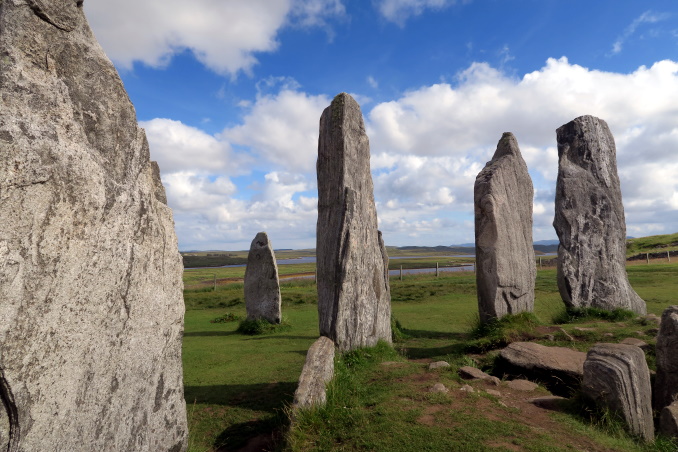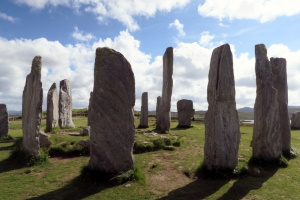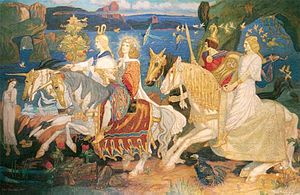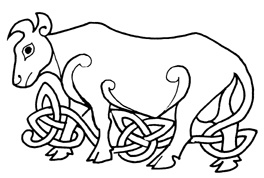Mystery of Scotland's Ancient Callanish Standing Stones

All around the Celtic world there are many cairns, stone circles, standing stones and carvings in rock dating from prehistory before the time of written records. Ancient stones and tombs placed in a way that look to the stars and capture moments of astronomical importance. The rising and setting of the sun and moon during the summer and winter equinoxes. According to archaeologists the ancient Irish were the first to record a solar eclipse 5,354 years ago. A geometric etching illustrating the eclipse is thought to lie inside the Cairn L. This is one of the two large focal monuments on Cairnbane West outside Kells in Ireland’s County Meath. The carving of concentric circles and lines is at the back of the chamber of the cairn.

It is clear that for our ancestors the constellations gave special meaning to the world. We no longer know the belief systems that the creators of these ancient Celtic stone monuments held. Nevertheless their astronomical knowledge appears clear. Research published in the Journal of Archaeological Science in 2016 revealed that the Scottish Callanish Stones on Lewis and the Standing Stones of Stenness on Orkney, both dating from about 4000 BC to 2600 BC, were constructed to align with the orbits of the sun and the moon. Using Ordnance Survey data on individual sites the researchers found that the stones were positioned to connect with the path of the sun and moon at different points in their cycle.
It seems that for a period the astrological significance of ancient megaliths was often forgotten. As time passed, these human made structures almost became part of the natural landscape. Nevertheless, they continued to hold an importance in folklore and legend. Celts have a rich tradition of legend and folklore which is often tied to a particular place and location. Our landscape, geographic location and wildlife has played a pivotal role in our history, beliefs and recognition of ourselves. For our culture tells us that we are part of and completely tied to the lands in which we live or from where we came. Pre-Christian Celtic beliefs perceived the presence of the supernatural in every mountain, river, coastal feature, spring, loch, marsh, tree, rock formation and ancient monuments. Early Celts maintained a polytheistic mythology and religious structure.

The Tuatha Dé Danann were pre-Christain gods that were a significant feature in Irish, Scottish and Manx mythology. They were believed to have supernatural ability and were of great importance to Gaelic people. They belong to the Otherworld (Aos Si) community whose world was reached through mists, hills, lakes, ponds, wetland areas, caves, ancient burial sites, cairns and mounds. Topography is a major feature of Celtic storytelling. So natural and artificial features are important in local history and culture, with place names also relating to alleged etymologies. It is not a surprise therefore that throughout the Celtic lands, each particular ancient monument, has attached to it a story or legend. Not least being the Callanish Stones (Scottish Gaelic: Clachan Chalanais). Thought to date from 4000 to 2600BC, these are a group of thirteen standing stones forming a circle about thirteen metres in diameter. There is an avenue of stones to the north and shorter rows to the east west and south. The location is near the village of Callanish (Calanais) on the west coast of Lewis (Leodhas) in the Outer Hebrides (TNa h-Eileanan Siar) of Scotland. Some refer to these stones as the Fir Bhreig, 'The False Men'. One folk tradition is that the stone pillars are said to be giants who refused to build a church for St. Keiran and were therefore turned into stone. They are believed to recover their original form and at certain times of the day or year, have the power of movement..

Another local legend says that early on a midsummer morning a mysterious entity known as ‘The Shining One’ walks the length of the avenue of the stones. His coming is heralded by the call of the cuckoo, the bird of the Celtic land of Tir-nan-Og, which is another description of the Celtic Otherworld. At one time there was a tradition for local people to visit the stones on that day and on May Day. There is a further tale associated with the Callanish Stones, when it is said that during a time of famine on the Island a desperate and starving woman lost all hope and went to the sea intending to drown herself. However, a white cow emerged from the waves and told her that she and all her neighbours should bring their milk pails to the stones of Callanish that night. They did and the cow provided each of them with a pailful of milk. This went on for some time until it is said a witch brought a sieve instead of a pail. As the cow could not fill the container no matter how hard she tried, she was milked dry, and was never seen on the Island again.
Content type:
- Scottish
Language:
- English





